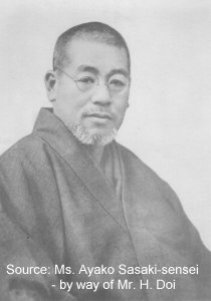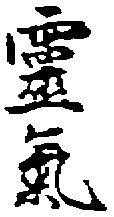
.Home / New to Reiki / Experienced / Miscellaneous
.

| The Usui Affirmations (also known as the precepts, concepts or principles) are
the heart of every system of Reiki that is attributed to Mikao
Usui. This includes the original Usui-Do, Usui Te-ate, Usui Reiki
Ryoho, and all early systems in Japan, and afterwards. As a student
grows his/her way through the structure of the system, eventually he/she
comes to a deeper understanding of their meaning.
The affirmations have been presented in many forms since Takata first taught the core part of them - what is known in Japan as the Gokai - and most have been similar in their wording. But recently, these versions have been found to be a little incomplete and slightly inaccurate. In June, 1996, I taught a Japanese fellow who was in Vancouver learning ESL (English as a second language). Just before leaving Japan he purchased a Reiki book called "Iyashi No Te" (Healing of Hands -- or Healing Hands). The author is Reiki Master Toshitaka Mochizuki, and this is the first modern Reiki book written by a Japanese. He has connections to many Reiki masters in Japan, some of whom have a lineage to another of Usui's students, Toshihiro Eguchi. In Mochizuki's book (written in Japanese), he had a copy of the original Usui precepts (in Mochizuki's handwriting). With the aid of one of my Japanese students, Emiko Arai, a group of Reiki Masters sat down to decipher this version of the precepts. Dave King also brought his own a copy of the original affirmations, in the handwriting of Mikao Usui. (The original precepts are stored in a private shrine to Usui Sensei somewhere in Tokyo). Emiko compared the modern day Japanese translation in Mochizuki's book to the copy of the original we had. If you have ever had to decipher someone's handwriting, you know that there are usually some words you have to guess at. It is the same with the handwritten version of the precepts; plus, this style of writing and the Japanese Kanji used, are a bit different from that in use today. Here is a VERY LITERAL TRANSLATION of the
precepts, using a Japanese to English dictionary. Please note that the
sentence structure is backward to that normally used in English (i.e. the
verb comes first). Also, the first 2 lines are actually heading
lines.
Note: the 4th and 5th lines were a bit confusing until we translated the Usui Memorial in 1998. We now understand what Usui Sensei meant was to "Be thankful", "Endeavour Your work" (which Emiko feels means your daily life work), and "Be kind to people" - at least that is how the memorial is phrased. However, Arjava Petter explained the meaning to the "Do your work" or "Endeavour your work" - saying that it really meant your own spiritual growth. So this is how translating goes <smile>. In any translation, you usually have several words to choose from, and you should pick ones that express the content of the whole, (and the culture). E.g. 'spiritual" may be more accurate in Japanese than "heavenly". So, if you try to put this into modern English, you get something like this:
|
| "Usui Sensei created (the) Gokai (the 5 principles) getting hints from a book "Kenzon no Genri"
(Principles of Health) written by Dr. Suzuki Bizan (published
in March, 1914.) The book
says 'Just for today, do not get angry, do not feel fear, be honest, work hard, and be kind to others.' " |
There is a Japanese
web page (thanks to Rudy Kedem for the
link) which discusses the above text from the book (in the last section at the bottom). George Mullen, an
Usui-doka, reviewed this and gave the following explanation:
| " The extract
comes out in Romanji as: Kyou take wa ikarazu osorezu / shoujiki ni shokumu o hagemi / hito ni shinsetsu " I would
translate this as: "Note the difference between ikara (to make someone else angry) and ikaru (to get angry) as used in O-sensei's concepts." |
It could have been a coincidence, or Usui Sensei could have noticed the phrase and become inspired by it. However it is interesting to note that the maiden name of Usui Sense's wife was also Suzuki. Whatever the source, those middle statements above in red called the Gokai are what the spiritual side of Sensei's system was all about. They were the true reference refereed to by the following term - Usui Reiki (to ancestor) Ryoho(remedy) or Usui Remedy for connecting with your ancestral self. In some schools like Gendai Reiki Ho and Usui-Do they are looked at in great detail.
When Melissa Riggall spent a month working with Mr. Tatsumi (a senior Hayashi student 1927-31) in 1996, she pointed to the kanji for "Reiki" in a photo of the original affirmations that Mr. Tatsumi had. She said this is what the Western world called the healing system. He said that the term is simply what O-Sensei (Usui - the term refers to the head of a system) used to refer to his ancestors.
Dr. Hayashi had taught him an inner spiritual system (the original Usui-Do) and an outer palm healing system that Usui's friend Eguchi created at the Usui-Do dojo in 1925. Together with the Navy students of Usui, Eguchi and Hayashi had formed a learning society (Gakkai) called Usui Reiki Ryoho Gakkai. The palm healing system was the main method being taught, with spiritual work being increased as one progressed. But the system was shortened to 3 or 4 levels and few learned the complete Usui-Do. Hayashi continued to teach both systems until at least 1931, while Eguchi may have taught both for longer.
 According to the log
book in Usui Sensei's private shrine (AGAIN, not the public
grave site), someone back in 1938 was allowed to take the portrait
of Usui out into the daylight and take a picture of it; a bold move for a
Japanese at that time. However, since Dr. Hayashi was an amateur
photographer and had taken the original photo, he was able to pass out
copies to to students. Note that the picture shown here is missing the
bottom part of the photograph which has some writing in Japanese, which
says that this is Mikao Usui, the Founder.
According to the log
book in Usui Sensei's private shrine (AGAIN, not the public
grave site), someone back in 1938 was allowed to take the portrait
of Usui out into the daylight and take a picture of it; a bold move for a
Japanese at that time. However, since Dr. Hayashi was an amateur
photographer and had taken the original photo, he was able to pass out
copies to to students. Note that the picture shown here is missing the
bottom part of the photograph which has some writing in Japanese, which
says that this is Mikao Usui, the Founder.
The name of the person in the log book is said to be difficult to read, but it also mentions that the same person was not allowed to remove the affirmations to photograph them. It is thought that this person may have simply sat down and copied them. However, this same version of the affirmations shows up on a picture of Usui Sensei that was handed out by one of his students (Keizo Ogawa), and is believed to be in Usui Sensei's own handwriting. So it would seem that photos were made of the precepts - possibly again by Dr. Hayashi when they hung in the Usui-dojo (training hall). The Ogawa version is now in the possession of Frank Arjava Petter and it appears in a couple of his books.
The original precepts also have red hankos or stamps on the left side, below the writing.
Below is a copy of a photograph of the handwritten version of the precepts. It is read column by column, from top to bottom, going from the right side to the left.
 |
In the 3rd column from the left in the above document you can see handwriting for the words Rei and Ki - it is part of the phrase - Usui Reiki Ryoho, which is what I have for the background image to this page . |
In the old Reiki Society,
Usui Reiki Ryoho
Gakkai (gah kie) the central part of the affirmations, called the
Gokai (goe-kie) are recited 3 times at the end
of the opening meditation - called Shuyo-ho.
|
Do not anger Do not worry. Be grateful Endeavour your work Be kind to all people |
Ikaruna Shinpai suna Kansha shite Gyo wo hageme Hito ni shinsetsu ni |
In the Shinpiden Level of Gendai
Reiki Ho, I learned a deeper understanding of the Gokai from my
teacher Mr.
Hiroshi Doi-sensei. It is very much in the spirit of the
original system of Usu.
| © Copyright 2000 Hiroshi Doi - Gendai Reiki ho Shinpiden
Manual
Five Reiki
Principles (Gokai) of Usui Sensei
|
Emiko Arai also offered a translation of the name, Mikao Usui. "Usu" means 'a large grain or rice mortar'; "i" means 'water well'; "Mika" is a very old name no longer in use that meant 'sacred rice wine cup or vessel', probably used in a spiritual offering; "o" denotes a masculine name.
Dave King also found another translation for "Mikao" in this dictionary:
TITLE: The modern reader's Japanese-English
character dictionary
AUTHOR: Nelson,
Andrew Nathaniel.
EDITION: 2nd rev.
ed.
PUBLICATION: Rutland, Vt. : C.
E. Tuttle Co., 1974, c1962.
It is radical #8, 16 strokes, kanji #335 and is on page 122. The meaning is Jar/jug/vat/urn/vase.
If you have comments or suggestions, Contact Me. I will try to answer them all.
1073